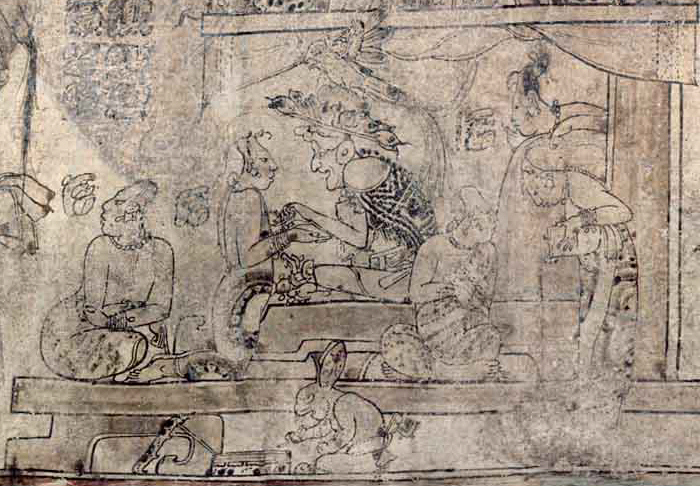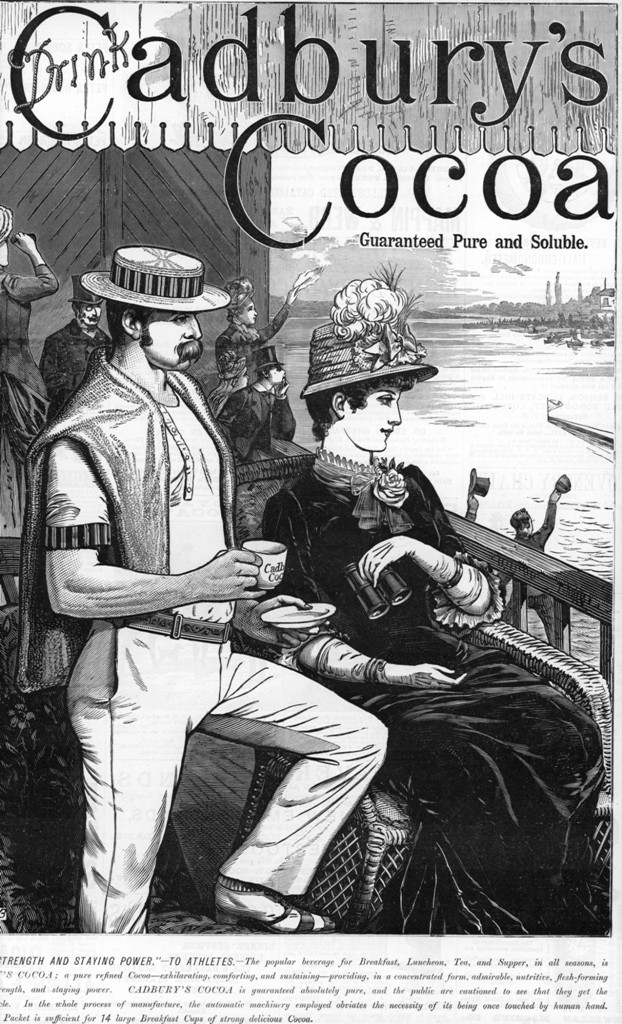My informant was chosen due to her self-proclaimed addiction to the product in question, chocolate. The following interview seeks to uncover the role that chocolate has played in her life, her current relationship with chocolate and her perception of chocolate on a global scale (i.e. production, certifications, etc.).
“When did you first find yourself falling in love with chocolate?”
“I started loving chocolate when I was seven years old.”
I started to laugh. “So you’re telling me that you know the exact age that you started to fall in love with chocolate?”
“Yes! I do and the reason I do was because that was how old I was when my mother married my stepfather. He was a New York City police officer and one of his weekend jobs was to work security for a candy factory, so my siblings and I would go along with my stepfather to the candy factory every Saturday. That’s probably why I had cavities.” Now she was the one laughing. “I was always so excited because we would get to drive the go karts around in the candy factory.”
“Go karts? In a candy factory?”
“Yes. It was actually called The Candy Factory and it was over in the Brooklyn Terminal Market. We would all ride around in those carts where you lift up cartons of candy and transport it out to the trucks that delivered them to the store. We would stop at each section in the factory and take whatever candy we wanted home with us for the weekend. It was like my stepfather’s payment for watching the factory. We would take home Reese’s peanut butter cups and Joyva jelly rings, which were chocolate covered raspberry rings, and those were my favorite. I fell in love with chocolate.”

(Image Retrieved from: http://groceryonlinemarket.com/product/joyva-jell-rings-chocolate-covered-3-ring-pack-1-35-ounces-pack-of-24/)
“Do you think that your love of chocolate came from the way your family felt about chocolate? Did your mother like to eat chocolate as much as you did?”
“Well, my mom likes to eat rasinettes but she mostly eats jelly donuts, so, no. I’m the chocaholic of the family and I turned my husband into one. When I met him 35 years ago he hated chocolate. He hated it! And then he lived with me and now he absolutely loves chocolate and he always wants to eat it. He got addicted to it because sugar is very addicting. He just didn’t like the taste of it before. You know how some people just like salty versus sweet? Well, he was just eating salty things. After living together for a while I noticed he would put chocolate on his sundaes or make chocolate covered strawberries. Pretty soon after that he was ordering chocolate cake at restaurants for dessert instead of cheesecake. He started drinking hot chocolate and mochas also. Oh god, I want a chocolate bar now.”
“Speaking of chocolate bars, what is your chocolate preference? How much cacao do you prefer in a chocolate bar?”
“70% because I love dark chocolate and it’s not too bitter at that point. Once you get past 70% though it is really bitter. My favorite brand of chocolate is See’s candies. When I walk into a See’s store I always say, “You should make perfume out of this!” It’s like aromatherapy. I love See’s and I like Lindt, which I think is Swiss. I know Belgium and Swiss chocolate is really delicious. It’s just creamy and it’s rich tasting. I love chocolate. It’s healthy and it’s an antioxidant. It’s also an anti-inflammatory I found out! I read that on the internet. Oh! And chocolate has endorphins, it gives you a feeling of happiness.”

(Image Retrieved from: https://www.riceepicurean.com/sees-candies/)
As it turns out, my informant was correct. Chocolate contains flavanols which act as an anti-inflammatory in the body, however, Goya et al. points out that flavanol concentrations vary among chocolate products (Goya et al. 2016, 212). A study conducted by Melchior et al. in 1991 also confirms that chocolate increases beta-endorphins after consuming chocolate beverages (Melchior et al. 1991, 941).
I figured this would be the perfect time to dive into the health aspects of chocolate. “Are there any reasons you would consider chocolate to be unhealthy?”
“Cholesterol. Chocolate increases your cholesterol, which is not heart healthy, although they say that chocolate does have antioxidants in it which are good for you! Also, there is too much sugar in it which just isn’t good for you when you are worried about diabetes! You have to be careful too because chocolate is an addiction so once you start eating chocolate you crave it. I did. I do. I still crave it. I can’t imagine life without chocolate. It’s totally my vice. I don’t smoke, I don’t drink much. If I had to be on an island, I would bring chocolate.”
The popular belief that chocolate increases cholesterol is no doubt derived from the common misconception that follows the meaning behind HDL’s, high-density lipoproteins, and LDL’s, low-density lipoproteins. According to the Center for Disease Control and Prevention, LDL’s are considered to be the “bad” form of cholesterol, with high levels raising risk for heart disease and stroke. HDL’s are considered to be the “good” form of cholesterol, lowering the risk for heart disease and stroke (CDC 2017). It is recognized that the anti-oxidant activity that follows the consumption of chocolate actually helps decrease ones low-density lipoprotein cholesterol activity while increasing ones high-density lipoprotein cholesterol levels (Wilson 2015, 17). Therefore, certain types of chocolate are considered to be heart healthy as they delay the progression of diseases such as atherosclerosis and arteriosclerosis (Wilson 2015, 17).
The notion that chocolate, which contains a lot of sugar, is a danger to those who have diabetes, seems like a completely rational statement. However, a study conducted in 2015 by Mellor et al. suggests that this may not be entirely true. As it turns out, small amounts of polyphenol rich chocolate, up to about 20-45g per day, can be safely added to the diets of those who have diabetes (Mellor et al. 2015, 9917). Unfortunately, it is not common for the level of polyphenol’s in chocolate to be labeled on products. As more research in this area continues, this may be expected to change (Mellor et al. 2015, 9917). After explaining the relationship between chocolate and cholesterol as well as chocolate with diabetes to my informant, we were able to continue the interview.
“How often would you say that you eat chocolate?”
“I used to eat chocolate at least three times a week but now I’ve cut my sugar down due to the cancer so I try to have it maybe once every two weeks. I would have a whole bar at a time, I couldn’t stop.”
“How did your consumption of chocolate change when you were diagnosed with breast cancer?”
“I got depressed. I still eat a little bit, not too much now. I modified my diet but I still can’t resist it every couple of weeks. They say to cut back on sugar because sugar feeds cancer so I don’t eat as much sugar in my diet but if I do eat sugar it is usually saved for dark chocolate. Last time I had a bag of dark chocolate peanut butter cups.
I became curious as to what exactly the relationship was between chocolate and cancer. According to a study in the European Journal of Cancer Care, dark chocolate contains catcehins which act as an anti-cancer compound or as a preventative for the development of cancer (European Journal of Cancer Care 2000, 131). However, it is also recognized that sugar fuels cancer. Receptors associated with cell survival in tumors are maintained through intracellular glucose levels and SGLT1’s, or the stabilization of the sodium glucose transporter 1 (Penson 2009, 918). It is then no wonder that those who have cancer are more likely to consume their catechins through less sugary products such as tea.
“When was your last chocolate binge?”
She started giggling again, as if I had caught her red handed doing something she was not supposed to be doing. “Honestly, it was yesterday. They were on sale! It was $4.99 for the bag and I wound up eating the whole thing in two days. That’s why I’m so happy right now. But I did gain back a pound that I had lost so I do seem to gain weight right away after I eat the chocolate.”
When my informant mentioned she had gained weight after eating chocolate, I decided to investigate the relationship between chocolate and obesity. This led me to a study conducted in 2013 by Gu et al. who conducted animal trials in an attempt to identify the positive effects of cocoa. The introduction of cocoa in mice was said to reduce obesity after just a ten week period (Grace et al. 2014, 795). While it is unclear whether or not certain levels of flavinols in cocoa, or in dark chocolate, are responsible for an anti-obesity effect in humans, the results from a variety of animal studies seems to point in that direction. However, more research in humans must be conducted before there can be any confirmation that this is the case. Dark chocolate, the product that my informant had consumed before her weight gain, contains “more cocoa butter and fat” than cocoa powder, which was analyzed in comparison with dark chocolate during the trials mentioned above (Grace et al. 2014, 793).
“Where do you usually buy your chocolate? For example, would you ever buy chocolate at a gas station?”
“Not unless I’m on Highway 5 for a long time and I’m dying for it. I used to buy the Mexican chocolate bars at the supermarket, melt them and make hot chocolate. Those bars have cinnamon in them, I don’t even have to add anything. They come in these round, circular containers that are yellow with red writing. I forget the name of the brand. I could look it up online!”

(Image Retrieved from: http://kitchenencounters.typepad.com/blog/2010/12/-mexican-chocolate-cinnamon-orange-brownies-.html)
“No, that’s alright. Thank you. So, which grocery stores do you go to when you purchase chocolate?”
“I like Whole Foods because they have a variety of different countries the chocolate comes from. I can easily find the Swiss chocolate or the Belgium chocolate in that store versus a Safeway. Also, Cost Plus Imports is a great place to buy chocolate.”
I decided to switch gears here a little bit and discuss the ways in which chocolate is processed. “What do you consider the term processed to mean?”
“Processed? I think that means adding substances to the food that isn’t naturally organic. It’s when you add chemicals and fats that are unhealthy so that it tastes better.”
This brings up another common misconception. Many people associate the term processed with the term unhealthy. As it turns out, that is not always the case. “According to the United States Department of Agriculture (USDA) processed food is defined as any raw agricultural commodity that has been subject to washing, cleaning, milling, cutting, chopping, heating, pasteurizing, blanching, cooking, canning, freezing, drying, dehydrating, mixing, packaging, or other procedures that alter the food from its natural state (MSU 2014). Chocolate actually undergoes many of these processes.
“Were you aware that chocolate is a processed food?”
“No, but at Trader Joes they have organic chocolate and I buy their organic 70% cacao dark chocolate.”
I could sense here that my informant believed that because the product was organic, it must not be processed. I decided to explore this idea further. “How do you feel about food that is marked organic?”
“I prefer it because I don’t want chemicals, pesticides and unnatural products in my food. I want to eat clean , especially after the remission of my cancer.”
The USDA claims that the term organic may be used on labels for raw or processed agricultural products (USDA 2018). Were you aware that processed products could be labeled as organic?
“No I wasn’t aware of that. I wish these labels would be more specific as far as letting us know exactly what is in the food or what has happened to the food.”
“Now that you know chocolate is processed, what steps do you think are involved in its’ production?”
“I have never thought about that. I actually never knew that it was processed. I assume they have to take it out of the pod, clean it, grind it, probably add sugar or some sweetener to it and put it in a mold. That’s all I can think of.”
My informant was correct, however, there were a few steps missing from her list. According to Dr. Martin (2018), the steps involved in processing chocolate are as follows: the harvesting of cacao pods, the extraction of seeds, fermentation, drying (in sun or over fire), sorting and bagging of beans, roasting, winnowing (aka deshelling, husking), Grinding in a metate, pressing in a hydraulic press, and finally, conching (Martin 2018, Lecture). I repeated this list to my informant and proceeded to ask her more questions.
I wanted to make sure she understood the steps that I had previously addressed. “What do you think winnowing means?”
“Widowing? Winn-o-wing? Can I look it up on google? Winnowing…winnowing…what do I think it means? I have no idea to be quite honest.”
“Winnowing, in this sense, means to de-shell or husk the cacao.”
“I would have never thought that. I winnow pistachio nuts, walnuts, I’ve winnowed! Yeah, winnow, I do that all the time. I never knew I was winnowing.”

(Image Retrieved from: http://www.chocablog.com/features/the-chocolate-tree-a-scottish-bean-to-bar-story/)
“Given the complex process involved in creating the chocolate that you see at the supermarket, how much would you say is a reasonable price to pay for a chocolate bar?”
“That depends on how much I’m buying but I usually won’t spend more than seven dollars on chocolate. I’ll either buy a really great chocolate bar or buy a bag of chocolate with peanut butter in it. If it’s over seven dollars though in one store visit I’ll say, forget it. I will only spend more than that if I am buying gifts for other people.”
By the end of this interview it had become clear that while chocolate as a product is readily available for consumption, the information concerning its’ production is not. Many people do not realize the complexity involved in creating the chocolate bar or fully understand the labels that are associated with the food that they consume. This experience as a whole was very eye-opening for my informant and acted as a reminder of what my own conceptions were surrounding chocolate when I had first began Dr. Martin’s course, “Chocolate, Culture, and the Politics of Food.”
Works Cited:
2017. “LDL and HDL Cholesterol: “Bad” and “Good” Cholesterol” Centers for Disease Control and Prevention (CDC), May 9. https://www.cdc.gov/cholesterol/ldl_hdl.htm
2018. “Electronic Code of Federal Regulations.” E-CFR, May 9. https://www.ecfr.gov/cgi-bin/text-idx?c=ecfr&sid=c4e0df8f46a4f4b6f56d80be31f95ed3&rgn=div6&view=text&node=7:3.1.1.9.32.4&idno=7#se7.3.205_1300
Farhat, G., Drummond, S., Fyfe, L., & Al‐Dujaili, E. (2014). Dark Chocolate: An Obesity Paradox or a Culprit for Weight Gain? Phytotherapy Research, 28(6), 791-797.
Goya, L., Martín, M., Sarria, B., Ramos, S., Mateos, R., & Bravo, L. (2016). Effect of Cocoa and Its Flavonoids on Biomarkers of Inflammation: Studies of Cell Culture, Animals and Humans. Nutrients, 8(4), 212.
Melchior, Rigaud, Colas-Linhart, Petiet, Girard, & Apfelbaum. (1991). Immunoreactive beta-endorphin increases after an aspartame chocolate drink in healthy human subjects. Physiology & Behavior, 50(5), 941-944.
Mellor, D., Sathyapalan, T., Kilpatrick, E., & Atkin, S. (2015). Diabetes and chocolate: Friend or foe? Journal of Agricultural and Food Chemistry, 63(45), 9910-8.
Parrish, Ashley. 2014. “What is a processed food?” Michigan State University (MSU), May 9. http://msue.anr.msu.edu/news/what_is_a_processed_food
Penson, R. (2009). Sugar fuels cancer. Cancer, 115(5), 918-921.
Wilson, Wilson, Philip K., Hurst, W. Jeffrey, & Royal Society of Chemistry. (2015). Chocolate and health : Chemistry, nutrition and therapy. Cambridge, UK: Royal Society of Chemistry.


















































You must be logged in to post a comment.